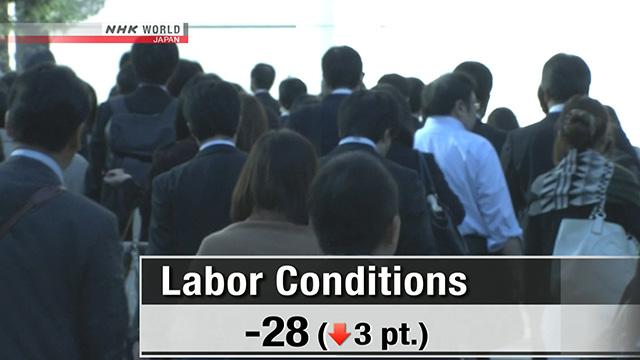The Bank of Japan asked more than 10,000 companies whether they have enough workers. The results show that the perception that there's a labor shortage has worsened to a point not seen in 25-and-a-half years.
An index for all companies came in at minus 28 points -- down 3 points from the previous survey. Negative figures indicate a labor shortage. The index fell deeper into minus territory for companies of all sizes. For large companies, it dropped 2 points to minus 18. It slid 5 points to minus 32 for small and midsize firms.
The survey also polled businesses about their forecasts on capital investment for the fiscal year through March. Manufacturers said they plan to increase spending by an average of 11.7 percent, and non-manufacturers, by 0.8 percent.
Analysts say many businesses are trying to cope with labor shortages by boosting investment to automate their operations.
Expert: Some sectors face crisis
Satoshi Osanai, senior economist at the Daiwa Institute of Research, says some sectors face a labor shortage crisis. He points out more firms will have no choice but to increase investment in automation.
Osanai expects that machines and computers will replace people as companies face difficulty securing workers.
But he says there's a limit to automation investment as some jobs like nursing care and retailing cannot be done by machines.
Osanai says drawing up measures to support the non-manufacturing sector, particularly smaller firms in rural areas, will be a major challenge for policymakers.
Robots support humans
Restaurant chains have introduced machines and robots to cope with the labor shortage.
Beef-bowl restaurant chain Yoshinoya equipped all of its outlets across Japan with machines to put rice into bowls. The machines automatically adjust the amount of rice according to the dish. This is aimed at cutting tasks handled by workers to allow them to serve customers more smoothly.
In January, the firm introduced a robotic arm at an outlet in Tokyo on a trial basis. Washing tableware used to take more than 2 hours every day. Now, workers just put everything into a dishwasher after removing bits of food with a power brush. After the dishwasher is done, the robot sorts out the load and creates different piles based on size. It sounds a buzzer to inform workers that its job is finished.
Firm officials say the robot has cut dishwashing time by around 20 percent. They want to upgrade the robot to finish the job in 30 minutes.
The officials plan to use advanced technologies to handle all the tasks, from storing ingredients to cleaning, as they predict securing workers will become even more difficult.
Shigeru Haruki, a manager at a research institute affiliated with Yoshinoya, says he believes more than half the jobs at their restaurants can be automated or handled by robots in the future. He says he wants to reduce the burden on workers so that they can focus on cooking and customer service.
Machines fill labor gap
Manufacturers have also been hit by the labor shortage. Some have turned to machines to manage their plants.
A plant in Hokkaido operated by major Japanese paper maker Nippon Paper Industries has been a major source of revenue for the local economy since it began operating in 1960.
The plant runs around the clock, producing 380,000 tons of paper a year. But it doesn't have enough engineers to inspect the production equipment.
The engineers use metal sticks to listen to sounds from the equipment to detect problems. But their number is dwindling as they reach retirement age. The plant needs 68 engineers, but it now has only 64, as hiring young people becomes difficult.
So officials have decided to use sensors to monitor the equipment's temperatures and vibrations. More than 500 sensors installed at the plant record data 24 hours a day and sound alarms as soon as they find any problems.
The developer of the sensors, Michihiro Fujiyama, says he had to come up with a new way to maintain the equipment amid the labor shortage. He says he believes the sensors are playing a major role in ensuring the plant's stable operation.
Nippon Paper plans to install the sensors at all 12 of its plants in Japan. It has also started selling the sensors to other firms, as many plant operators suffer from the labor shortage.
Mitsuhiro Sugino, who heads the firm's management planning department, stresses the need to develop technologies for running plants without relying on people. He says companies will have no choice but to turn to them in the future.
Latest technologies in worker management
The utilization of cutting-edge technologies at points of production goes beyond dealing with manpower shortages. They're being used to instruct the staff, as well as manage their performances.
A Panasonic plant in Tosu City, Saga Prefecture is manufacturing equipment such as credit card readers for cash registers and security cameras.
The leading electronics firm is also producing robots that automatically check whether products operate properly before shipment.
In the semiconductor substrate production line, workers check equipment using wearable computers in the form of glasses. Their lens displays a list of inspection items.
After the inspection is complete, all the workers have to do is report their results into a microphone. The system automatically stores the data.
Moving cameras are installed on the ceiling. They use image-analysis technology to monitor workers' operations.
When there's a delay in operations, the display turns red, alerting a drop in efficiency. The 19 cameras automatically track and record the movements of the workers where the delay is happening. The system analyzes its causes to improve efficiency.
Taro Nanri, the head of the Panasonic Saga plant, says relying on people won't ensure stable manufacturing. He wants to utilize the information obtained from their equipment. Nanri says technology and artificial intelligence will help Japanese manufacturing evolve.
